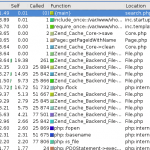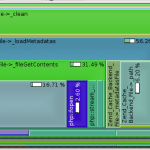The SlimFramework is a ‘minimal’ PHP5 framework. We’re using it in one project, integrating with Smarty, Propel and the Zend Framework (as I don’t like Zend_View, it didn’t seem worth using Zend_Controller_Action, although what we do have is very similar to one).
Anyway, when creating your front controller in Slim, you can define ‘middleware‘ (i.e. call back functions) which are executed when a route matches and runs – before your actual ‘controller’ code.
So for example, a simple route would look like :
Slim::get('/route/path/to/match', function() { echo "some output goes here"; }; );
With additional ‘middleware’ it could look like :
Slim::get('/routeh/path/to/match', $caching_middleware, $authentication_check, function() { echo "some output goes here";}; );
(Obviously in a real application you wouldn’t have echo statements in the front controller class)
The $caching_middleware could look like :
$cache_it = function () {
$cache = Zend_Cache::factory('Page', 'File',
array('debug_header' => true,
'default_options' => array('cache' => true,
'cache_with_get_parameters' => false,
'cache_with_session_variables' => true,
'cache_with_cookie_variables' => true),
));
$cache->start();
};
(I’ve left the debug_header in, so it’s obvious when it’s working 🙂 ).
And $authentication_check is another call back – this time presumably checking $_SESSION for something….


